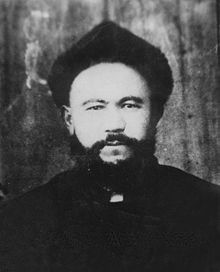Sabit Damulla Abdulbaki
| Sabit (Sawut) Damulla Abdulbaqi | |
|---|---|

Sabit Damolla Abdulbaki in his 20s-30s
|
|
| Prime Minister of the Turkish Islamic Republic of East Turkestan | |
|
In office 12 November 1933 – 6 February 1934 |
|
| Preceded by | Office instituted |
| Succeeded by | Office abolished |
| Personal details | |
| Born | 1883 Artush, Qing China |
| Died | 1934 Urumqi, Republic of China |
| Political party |
|
| Religion | Islam |
Sabit Damulla (Chinese: 沙比提大毛拉) (ثابت داملا عبد الباقي) (1934-1883) (سابىت داموللا عبدالباقى) was a Uyghur independence movement leader who led the Khotan rebellion against the Xinjiang Province government of Jin Shuren, and later the Uyghur leader Hoja-Niyaz. He is widely known as the only prime minister of the short-lived Turkish Islamic Republic of Eastern Turkestan from November 12, 1933 until the republic's defeat in May 1934.
Sabit (Sawut) Damulla Abdulbaqi was born in 1883, in county of Atush in the Kashgar vilayet, where he received religious education. In 1920s he graduated from Xinjiang Academy of Politics and Laws in Urumqi (later becoming Xinjiang University), that was founded by Governor Yang Zengxin in 1924 and originally performed courses in Chinese, Uyghur, and Russian. After completing university, he visited the Middle East, touring Egypt, Turkey, and Saudi Arabia; he also visited the Soviet Union, where he continued his studies. In 1932 he returned to Xinjiang through India, where he joined Emir Muhammad Amin Bughra in preparing a rebellion in Khotan district. Sabit Damulla was convinced that the Islamic world was not interested in supporting Uyghur independence, and so he turned to the Great Powers instead. Yang Zengxin had closed the publihing venture in Artush owned by Sabit Damulla. Sabit was a Jadidist.
...
Wikipedia
